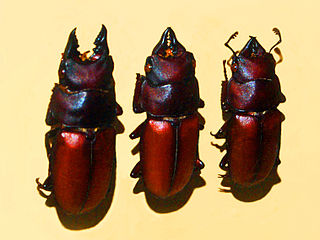
Papilio is a genus in the swallowtail butterfly family, Papilionidae, as well as the only representative of the tribe Papilionini. The word papilio is Latin for butterfly.

John Obadiah Westwood was an English entomologist and archaeologist also noted for his artistic talents. He published several illustrated works on insects and antiquities. He was among the first entomologists with an academic position at Oxford University. He was a natural theologian, staunchly anti-Darwinian, and sometimes adopted a quinarian viewpoint. Although he never travelled widely, he described species from around the world on the basis of specimens, especially of the larger, curious, and colourful species, obtained by naturalists and collectors in England.

The organ pipe mud dauber is a predatory wasp in the family Crabronidae. They are fairly large wasps, ranging from 3.9–5.1 cm, and have been recorded to fly from May to September. Female and male are similar in colour, a shiny black, with the end part of the back leg being pale yellow to white. The organ pipe mud dauber feeds mainly on three genera of spider: Neoscona, Araneus, and Eustala. Melittobia, a parasitoid wasp, is a common ectoparasite of T. politum prepupae. Other sources of parasitism include the Bombyliid fly Anthrax, Chrysidid wasps, and various species of scavenger flies (Miltogramminae). The tufted titmouse is a known predator of T. politum, and may feed on them more commonly than previously thought as the holes made by the titmouse are similar in shape and size to those made by T. politum leaving the nest after pupation.

Saiva is a genus of Asian planthoppers, family Fulgoridae. They are colourful insects, marked boldly in red, blue, white and black, with a prominent slender stalk like structure arising on the head that points upwards or forward. The known distribution is from India, through Indo-China to Borneo.

Flower chafers are a group of scarab beetles, comprising the subfamily Cetoniinae. Many species are diurnal and visit flowers for pollen and nectar, or to browse on the petals. Some species also feed on fruit. The group is also called fruit and flower chafers, flower beetles and flower scarabs. There are around 4,000 species, many of them still undescribed.

Westwood United Methodist Church is a historic Methodist church in Cincinnati, Ohio, United States. Constructed in 1896 for an established congregation, it has been named a historic site.

Parides montezuma, the Montezuma's cattleheart, is a butterfly in the family Papilionidae. It is native to the Americas.

Acanthocephala is a New World genus of true bugs in the family Coreidae. The name is derived from the Greek akanth- meaning "thorn/spine" + kephale meaning "head" This name is in reference to the spine on the front of the head.
Gnathoxys is a genus of beetles in the family Carabidae, containing the following species:

Prosopocoilus is a genus of beetles of the family Lucanidae.

Psydrinae is a subfamily of beetles in the family Carabidae.

Scaritinae is a large subfamily of beetles in the family Carabidae, containing more than 2400 species in over 140 genera. They are found worldwide.
Carenum is a genus of beetles in the family Carabidae, containing the following species:
Carenum smaragdulum is a species of ground beetle in the subfamily Scaritinae. It was described by Westwood in 1842.
Carenum sumptuosum is a species of ground beetle in the subfamily Scaritinae. It was described by John O. Westwood in 1842.
Carenum scaritoides is a species of ground beetle in the subfamily Scaritinae. It was described by Westwood in 1843.
Dorcadion politum is a species of beetle in the family Cerambycidae. It was described by Dalman in 1823.

Cremastocheilini is a tribe of scarab beetles in the family Scarabaeidae. There are over 40 genera in the tribe Cremastocheilini.
Macrocephalus is a genus of ambush bugs in the family Reduviidae. There are more than 30 described species in Macrocephalus.
Leiobunum politum is a species of harvestman in the family Sclerosomatidae. It is found in North America.











